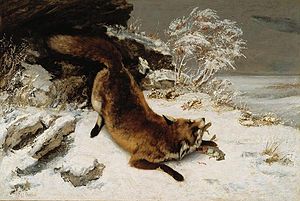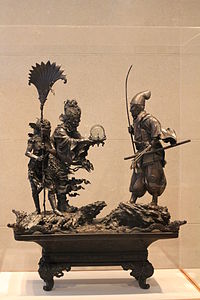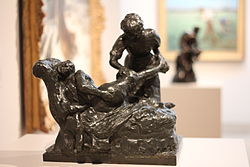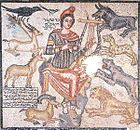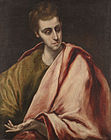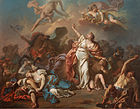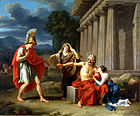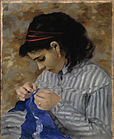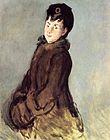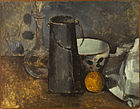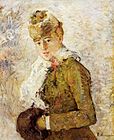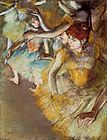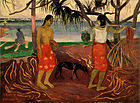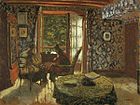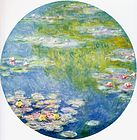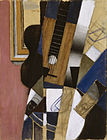- Dallas Museum of Art
-
Dallas Museum of Art 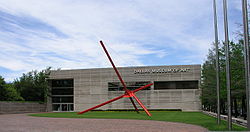
Established 1903 Location 1717 N. Harwood, Dallas, TX Woodall Rodgers Freeway, Dallas, Texas, USA Website Dallas Museum of Art The Dallas Museum of Art (DMA) is a major art museum located in the Arts District of downtown Dallas, Texas, USA, along Woodall Rodgers Freeway between St. Paul and Harwood. In 1984, the museum moved from its previous location in Fair Park to the Arts District, Dallas, Texas.[1] The new building was designed by Edward Larrabee Barnes, the 2007 winner of the American Institute of Architects Gold Medal.[2]
The Dallas Museum of Art collection is made up of more than 24000 objects, dating from the third millennium BC to the present day. The museum is also defined by its dynamic exhibition policy[3] and award-winning educational programs.[4] The Mildred R. and Frederick M. Mayer Library (the museum’s non-circulating research library) contains over 50,000 volumes available to curators and the general public.
Contents
History
The Dallas Museum of Art's history began with the establishment in 1903 of the Dallas Art Association, which initially exhibited paintings in the Dallas Public Library. Frank Reaugh, a Texas artist, saw in the new library the opportunity to display works of art.[5] This idea was championed by May Dickson Exall, who was the first president of the Dallas Public Library. Her intention was the following: “to offer art interest and education through exhibitions and lectures, to form a permanent collection, to sponsor the work of local artists, to solicit support of the arts from individuals and businesses, and to honor citizens who support the arts.”
The Museum’s collections started growing from this moment on. It soon became necessary to find a new permanent home. The museum, renamed the Dallas Museum of Fine Arts in 1932, relocated to a new art deco facility within Fair Park in 1936, on the occasion of the Texas Centennial Exposition.[6] This new facility was designed by a consortium of Dallas architects in consultation with Paul Cret of Philadelphia. It is still possible to visit this building.
In 1943 Jerry Bywaters became the director of the DMFA, a position he held for the next twenty-one years.[7] Artist, art critic, and teacher, Bywaters gave a sense of identity and community to the museum.[8]
Fox In The Snow, by Gustave Courbet (1860), Dallas Museum of Art
Under Bywaters' tenure, impressionist, abstract, and contemporary masterpieces were acquired and the Texas identity of the museum was emphasized. This identity is today represented by works by Alexandre Hogue, Olin Herman Travis, Bywaters himself, and others.
In 1963 the Dallas Museum of Fine Arts merged with the Dallas Museum of Contemporary Art,[9] whose director for the previous four years had been Douglas MacAgy. In 1964 Merrill C. Rueppel became the director of the newly merged Museum. The permanent collections of the two museums were then housed within the DMFA facility, suddenly holding significant works by Paul Gauguin, Odilon Redon, Henri Matisse, Piet Mondrian, Gerald Murphy, and Francis Bacon. In 1965, the museum held an exhibition called The Art of Piet Mondrian and one entitled Sculpture: Twentieth Century.[10]
By the late 1970s, the greatly enlarged permanent collection and the ambitious exhibition program fostered a need for a new museum facility. Under Harry Parker’s direction, the museum was able to move once again, to its current venue, at the northern edge of the city’s business district (the now designated Dallas Arts District). The $54 million dollar facility, designed by New York architect Edward Larrabee Barnes, was financed by a 1979 City bond election, together with private donations. The project was galvanized by the slogan “A Great City Deserves a Great Museum,” and the new building opened in January 1984.[11]
Collections
The museum's collections[12] include more than 24,000 works of art from around the world ranging from ancient to modern times. They are conceived as a celebration of the human power of creation.[13]
- The Dallas Museum of Art collection of ancient Mediterranean art includes Cycladic, Egyptian, Greek, Roman, Etruscan, and Apulian objects. Highlights of Egyptian art is a painted limestone Relief of a Procession of Offering Bearers from the Tomb of Ny-Ank-Nesut from 2575-2134 BC. The more extensive Greek collection includes a marble Figure of a man from a funerary relief from 300 BC, bronze sculptures, decorative objects, and gold jewelry. The art of ancient Rome is represented by a Figure of a woman from the 2nd century AD and a marble sarcophagus carved in high relief with a battle scene, c. 190 AD.
- The museum’s collections of South Asian art range from Gandharan Buddhist art of the 2nd to 4th centuries AD to the arts of the Mughal Empire in India from the 15th to the 19th century. Highlights include a 12th century bronze Shiva Nataraja and a 10th century sandstone representation of the god Vishnu as the boar-headed Varaha. The arts of Tibet, Nepal, and Thailand are also represented.
 Sheaves of Wheat, by Vincent van Gogh (1890), Dallas Museum of Art
Sheaves of Wheat, by Vincent van Gogh (1890), Dallas Museum of Art
- The Dallas Museum of Art’s collection of European art starts in the 16th century. Some of the earlier works include paintings by Giulio Cesare Procaccini (Ecce Homo, 1615–18), Pietro Paolini (Bacchic Concert, 1630), and Nicolas Mignard (The Shepherd Faustulus Bringing Romulus & Remus to His Wife, 1654). Art of the 18th century is represented by artists like Canaletto (A View from the Fondamenta Nuova, 1772), Jean-Baptiste Marie Pierre (The Abduction of Europa, 1750), and Claude-Joseph Vernet (Mountain Landscape with Approaching Storm, 1775). The loan of the Michael L. Rosenberg collection brings an added depth to the museum’s 18th century French collection.[14] The 19th and 20th century collection of European art also stands out. Among significant works in this collection are Fox in the Snow by Gustave Courbet (1860), The Seine at Lavacourt by Claude Monet (1880), I Raro te Oviri by Paul Gauguin (1891), Beginning of the World by Constantin Brâncuşi (1920), Interior (1902), and Les Marroniers ou le Vitrail (1894) by Edouard Vuillard. The collection of works by Piet Mondrian is also particularly noteworthy (with works like The Windmill (1908), Self-Portrait (1942), and Place de la Concorde (1938–43).[15]
- The Wendy and Emery Reves Collection.[16][17] In 1985 the Dallas Museum of Art received a one-of-a-kind gift from Wendy Reves in honor of her late husband, Emery Reves. The Reves collection is housed in an elaborate 15,000-square-foot (1,400 m²) reproduction of the couple' home in France, Villa La Pausa, where the works were originally displayed. This villa was originally created by Gabrielle "Coco" Chanel in 1927, and some of the original furniture is kept in its context.
Among the 1,400 paintings, sculptures, and works on paper Emery Reves had collected are works from leading impressionist, post-impressionist, and early modernist artists, including Paul Cézanne, Honoré Daumier, Edgar Degas, Paul Gauguin, Edouard Manet, Claude Monet, Camille Pissarro, Auguste Renoir, Henri de Toulouse-Lautrec, and Vincent van Gogh. Another part of the Reves wing is devoted to decorative arts and includes Chinese export porcelain; European furniture; Oriental and European carpets; iron, bronze, and silver work; antique European glass; and rare books. Paintings in the Reves collection are also noted for the beauty of their frames. Memorabilia of the Reveses' friendship with English statesman Winston Churchill is housed in the wing as well.The Masseuse, by Edgar Degas (between 1896-1911)

- Objects in the Dallas Museum of Art’s highly regarded African collection come from West Africa and Central Africa.The objects date primarily from the 16th to the 20th centuries, although the earliest object is a Nok terracotta bust from Nigeria that dates from somewhere between 200 BC to 200 AD. Some works in the collection were created as symbols of leadership and status, while others express concepts related to the cycle of life. Highlights of the collection include a Benin plaque of copper alloy over wood depicting a warrior chief, a carved wood Senufo rhythm pounder from southeastern Mali, and a Congo standing power figure studded with ritually embedded iron nails or blades.
- The Dallas Museum of Art has significant holdings of ancient American art. The collection covers more than three millennia, displaying sculptures, prints, terracotta, and gold objects. Among the other highlights are gold objects from Panama, Colombia and Peru and the Head of the god Tlaloc (Mexico, 14th-16th century).
- The American art collection includes paintings, sculptures, and works on paper from the United States, Mexico, and Canada from the colonial period to World War II. Among the highlights of the collection are Duck Island (1906) by Childe Hassam, Lighthouse Hill (1927) by Edward Hopper, That Gentleman (1960) by Andrew Wyeth, Bare Tree Trunks with Snow (1946) by Georgia O’Keeffe and Razor and Watch by Gerald Murphy (1924, 1925). One of the most beautiful pieces in the collection is The Icebergs (1861) by Frederic Edwin Church. This painting had long been referred to as a lost masterpiece. The painting was given to the museum in 1979 by Norma and Lamar Hunt. The Dallas Museum of Art also has one of the most thorough collections of Texas art. This is in great part thanks to Jerry Bywaters, director of the DMA from to 1943 to 1964, who was also one of the Dallas Nine, an influential group of Texas artists. In addition to paintings by Bywaters, the DMA has great works by Robert Jenkins Onderdonk, Julian Onderdonk, Alexandre Hogue, David Bates, Dorothy Austin, Michael Owen, and Olin Herman Travis.
- Every important artistic trend since 1945 is represented in the Dallas Museum of Art’s vast collection of contemporary art,[18] from abstract expressionism to pop and op Art, and from minimalism, and conceptualism to installation art, assemblage, and video art. Contemporary artists within the collection whose reputations are well established include Jackson Pollock, Mark Rothko, Franz Kline, Jasper Johns, Robert Rauschenberg, Bruce Nauman, and Robert Smithson. Among photographers represented in the collection are Cindy Sherman, Nic Nicosia, Thomas Struth, and Lynn Davis. When the current Museum facility opened in the mid-1980s, several artists were commissioned to create site-specific works especially for the Dallas Museum of Art: Ellsworth Kelly, Sol LeWitt, Richard Fleischner, and Claes Oldenburg with Coosje van Bruggen. In recent years, the museum has shown a strong interest in collecting the work of contemporary German artists such as Gerhard Richter, Sigmar Polke, and Anselm Kiefer.
Community events
In 2008 the Dallas Museum of Art premiered the Center for Creative Connections (also known as C3), a 12,000-square-foot (1,100 m2) facility for interactive learning experiences. The center presents exhibitions featuring the museum’s collections and artists’ and community partners’ responses to them. Spaces include the Art Studio, Tech Lab, Theater, and Arturo’s Nest.[19]
The Dallas Museum of Art also hosts numerous community outreach programs throughout the year, including:
- Late Nights: once a month the museum is open until midnight with performances, concerts, readings, film screenings, tours and family programs.
- Arts & Letters Live: a lecture series featuring acclaimed authors, actors, illustrators, and musicians.
- Jazz Under the Stars: a popular free outdoor jazz concert series on the museum's lawn
- Thursday Night Live: every Thursday evening there are live jazz concerts, dinner and drinks in the cafe, and artist encounters in the Center for Creative Connections.
Gallery
-
Gold Wreath, Greek, c.300-400 B.C.
-
Eros Lamp Holder, Greek, c.25-50 B.C.
-
Sarcophagus with battle scene, Roman, c.190 B.C.
-
Black-Figure panel amphora (Achilles fighting over the dead body of Antilochus with the Trojan hero Prince Memnon), Greek, c.575 B.C.
-
St. John, El Greco (or his student), 1590-1595
-
Apollo and Artemis attacking the twelve children of Niobe, Jacques-Louis David, 1772
-
The Fountain of Vaucluse, Thomas Cole, 1841
-
Tiger Surprising an Antelope, Antoine-Louis Barye, 1857
-
Lise Sewing, Pierre-Auguste Renoir, 1866
-
Isabelle Lemonnier with a Muff, Edouard Manet, 1879
-
Still Life with Carafe, Milk Can, Bowl, and Orange, Paul Cézanne, 1879-80
-
Winter (Woman with a Muff), Berthe Morisot, 1880
-
The Seine at Lavacourt, Claude Monet, 1880
-
Ballet Dancers on the Stage, Edgar Degas, 1883
-
The Pilgrim at the Gate of Idleness, Edward Burne-Jones, 1884
-
I Raro te Oviri, Paul Gauguin, 1891
-
The Laundress, Blue Room, Felix Vallotton, 1900
-
Dorothy, John Singer Sargent, 1900
-
Still Life with Apples, a Bottle and a Milk Pot, Paul Cézanne, 1900-06
-
Interior, Edouard Vuillard, 1902
-
Water Lilies, Claude Monet, 1908
-
Guitar and Pipe, Juan Gris, 1913
-
Emma in a Purple Dress, George Bellows, 1920-23
-
Indian Summer, Vermont, Willard Metcalf, 1922
See also
- List of buildings and structures in Dallas, Texas
References
- ^ http://www.thedallasartsdistrict.org/
- ^ http://archrecord.construction.com/news/daily/archives/061207barnes.asp
- ^ http://www.dm-art.org/Research/ExhibitionHistory/index.htm
- ^ http://www.dm-art.org/PressRoom/dma_291200
- ^ http://www.dm-art.org/AboutUs/MuseumHistory/index.htm
- ^ http://www.texascentennial.com/
- ^ http://www.tshaonline.org/handbook/online/articles/fby14
- ^ http://smu.edu/meadowsmuseum/about_Bywaters.htm
- ^ http://dallasmuseumofart.org/idc/groups/public/documents/web_content/dma_295634.pdf
- ^ http://www.dm-art.org/Research/ExhibitionHistory/index.htm
- ^ http://www.dm-art.org/PressRoom/dma_262208
- ^ ’’Dallas Museum of Art, A Guide to the Collection’’ Managing Editor: Debra Wittrup (1997)
- ^ http://dallasmuseumofart.org:8080/emuseum/objects/viewcollections/Objects
- ^ http://www.dm-art.org/PressRoom/Archives/dma_205781
- ^ http://www.absolutearts.com/artsnews/2001/08/20/29010.html
- ^ “The Wendy and Emery Reeves Collection”, Richard R. Bretell (1995)
- ^ http://www.jstor.org/pss/882521
- ^ Fast Forward: Exhibition Catalogue. Contemporary Collections for the Dallas Museum of Art, Edited by Maria de Corral and John R. Lane, 2007
- ^ http://www.dm-art.org/Events/CenterforCreativeConnections/About/index.htm
Bibliography
- Dallas Museum of Art 100 Years, Dorothy Kosinski with Lauren Schell (2003)
- Dallas Museum of Art, A Guide to the Collection, Managing Editor: Debra Wittrup (1997)
- http://www.dm-art.org/AboutUs/MuseumHistory/index.htm
External links
Coordinates: 32°47′14″N 96°48′03″W / 32.78722°N 96.80083°W
Categories:- Arts in Dallas, Texas
- Museums in Dallas, Texas
- Art museums in Texas
- FRAME Museums
- Museums established in 1903
- Institutions accredited by the American Association of Museums
Wikimedia Foundation. 2010.


